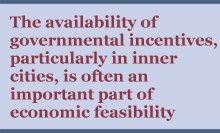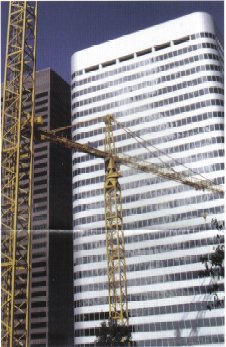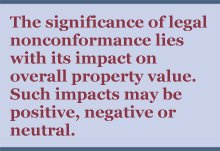

|
207 Abbey Lane Lansdale, Pennsylvania 19446 215-855-1800 |
5201 Ocean Avenue #2007 Wildwood, New Jersey 08260 215-990-6663 |
Specializing in Real Estate Appraisal and Property Tax Consulting
A Professional Courtesy of:
|

Specializing in Real Estate Appraisal and Property Tax Consulting |
| AUTUMN 2007 |
 |
|
In This Issue: |
|
The Impact of Wetlands The identification of wetlands is far from a straightforward exercise. Wetlands may, in fact, not always be "wet," particularly during dry periods. There is no single definition of wetlands. The 1986 Emergency Wetlands Resource Act defined wetlands as "land that has a predominance of hydric soils and that is inundated or saturated by surface or groundwater at a frequency and duration sufficient to support, and that under normal circumstances does support, a prevalence of hydrophytic vegetation typically adapted for life in saturated soil conditions."Wetlands are differentiated by distinct soils, hydrology and vegetation. There are five basic types of wetland systems: marine, estuarine, riverine, lacustrine and palustrine. The determination of specific wetland areas requires the expertise of specialists. Such professionals identify wetlands in one of two ways, either off-site (desk) or on-site (field) investigations. On-site investigations are generally made only if insufficient information is available for an off-site investigation. The importance of wetlands can be segmented into physical, legal, social and economic elements. Physical importance is manifest in wetlands as wildlife habitats, water filters and flood protection mechanisms. In legal terms, the purpose of the 1986 federal legislation was "to promote the conservation of migratory waterfowl and to offset or prevent the serious loss of wetlands by the acquisition of wetlands and other essential habitat." In terms of social and economic benefits, wetlands serve the interests of hunters, fishermen and the leisure industry. Wetlands valuation has been the source of controversy. Real estate valuation is generally on the basis of market value. However, environmentalists, academicians and some government agencies typically express the value of wetlands on the basis of "total economic value." This value is the sum of market value (as that term is generally used) and public interest value," defined in The Dictionary of Real Estate Appraisal (Fourth Edition) as "a general term covering a family of value concepts that relate the highest and best use of property to noneconomic uses such as conservation and preservation." Much of the controversy is due to a lack of understanding of the difference between the definitions of each value premise. In valuing properties having wetlands, it is critical that the appraiser have a sound understanding of the extent of wetlands as a portion of the entire tract for both the property being appraised and comparable sales. Sales analysis may be done as a "whole-to-whole," "sum of the parts" or "residual" analysis. A relatively recent tool for wetlands preservation is known as wetland mitigation banking. Mitigation banks have been created by both government and private sector sponsors, on both a nonprofit and for-profit basis. When development impacts wetlands, developers may purchase offsetting credits from a wetland mitigation bank. Special permits are required to establish a mitigation bank. Such banks require competent management and adequate funding. Wetlands have unique characteristics that necessitate the utilization of skilled and experienced professionals before informed decisions can be made. |
Hotel/Condominium Development In recent years, there has been .significant development of vertical mixed-use projects, particularly those combining hotels and residential condominiums. Such projects are in the form of new construction as well as redeveloped older structures. In the case of the latter, the availability of governmental incentives, particularly in inner cities, is often an important part of economic feasibility.The appeal of the concept is due to various factors. From the developer's perspective, such a project may result in greater site density than would otherwise be the case. This is particularly significant in those urban areas in which land prices have escalated sharply.  Condominium owners benefit from shared services with the hotel, including restaurants and room service/catering. In some cases, there may be a retail .component on the lower building level. Such benefits are aligned with the overall "carefree lifestyle" enjoyed by residential condominium owners.
Condominium owners benefit from shared services with the hotel, including restaurants and room service/catering. In some cases, there may be a retail .component on the lower building level. Such benefits are aligned with the overall "carefree lifestyle" enjoyed by residential condominium owners.Given varied ownership, it is typical for a master condominium regime to be created. There may be multiple subregimes within such a property, within which individual ownership of the hotel, retail and residential condominiums is vested. Given the interrelatedness of the use components, it is important to provide the greatest degree of autonomy possible to each such use. This is accomplished by the use of separate entrances, utility systems, elevators, parking and service/loading facilities. In addition to the obvious attractiveness of such separation to residential unit owners, the need for expense and maintenance cost allocation is minimized or eliminated.  Such projects require careful analysis and underwriting by lenders. If one lender finances the construction of the entirety, risk is increased since both the hotel and residential components must be successful. If either falters in terms of market acceptance, the entire development is at risk. Clearly, the experience and financial capability of the sponsor is of critical importance to the lender and the unit owners.
Such projects require careful analysis and underwriting by lenders. If one lender finances the construction of the entirety, risk is increased since both the hotel and residential components must be successful. If either falters in terms of market acceptance, the entire development is at risk. Clearly, the experience and financial capability of the sponsor is of critical importance to the lender and the unit owners.The form and substance of governing documents (e.g., declaration and bylaws) arc extremely important. Such documents should be drafted by legal counsel having as much experience as possible in such matters. Given the interdependence of the uses within vertical mixed-use buildings, representations made to prospective purchasers are inordinately important. If residential purchasers are told that the hotel will be luxury in quality, the signing of a mid-market or budget hotel franchise agreement will almost certainly result in litigation. Furthermore, the establishment of clear and accurate expectations regarding operating expense and capital expenditure responsibilities is extremely important. Mixed-use urban development is attractive for several reasons. However, the complexity of such properties due to specialized experience by the entire project team is essential for success. |
The Valuation of Historic Properties Interest in preserving historical structures has been prevalent in the United States for decades, driven in large part by recognition of the significance of our cultural and architectural heritage. The valuation of such properties presents the professional with unique challenges.Historical properties can be both residential and commercial in terms of usage. There are several means of recognizing and protecting historic properties. These mechanisms are federal, state and local in nature. A variety of financial incentives is used to encourage historic preservation. For example, income-producing properties may be eligible for a 20% federal investment tax credit for certified rehabilitation work on certified historic structures. Single-family properties do not qualify for this credit. Renovation work must be performed in compliance with the U.S. Secretary of the Interior's Standards for Rehabilitation.  A federal income tax deduction for the gift or donation of a certified historic structure (both income-producing and residential structures) is also available. Local incentives may include property tax incentives, tax increment financing and facade ease-merits. The latter provides for the donation of an easement preserving the facade of a historic structure. In return, local government may purchase the easement. Alternatively, owners may obtain a federal tax deduction equivalent to the market value of the facade easement.
A federal income tax deduction for the gift or donation of a certified historic structure (both income-producing and residential structures) is also available. Local incentives may include property tax incentives, tax increment financing and facade ease-merits. The latter provides for the donation of an easement preserving the facade of a historic structure. In return, local government may purchase the easement. Alternatively, owners may obtain a federal tax deduction equivalent to the market value of the facade easement.The valuation of facade easements has drawn increased scrutiny in the recent past due to concerns regarding excessive deductions taken by owners. In the past, a value equal to roughly 10% of the value of the improvements was generally regarded as reasonable. However, this is no longer the case. The valuation of a facade easement should be based on the diminution in value, if any, of the structure as a result of the easement. This is done on a "before and after" basis, i.e., the value of the property before and after the dedication of the easement. Such a loss in value is generally due to the inability to develop the property to a higher and better use, usually in areas of strong demand for new development. The remaining economic life of the subject improvements is also a key determinant. If 35 years of economic life remain, one may be hard pressed to support a diminution in value due to lost redevelopment opportunities. The availability and utilization of financial incentives is often critical to the economic feasibility of historic preservation and renovation. Without such incentives, many such projects would not be undertaken.  Historic properties have several differentiating characteristics. First, there is likely to be a more limited market for historic properties than for more contemporary structures. Both buyers and tenants of historic properties must appreciate such structures and be willing to deal with differences in functionality compared with newer properties.
Historic properties have several differentiating characteristics. First, there is likely to be a more limited market for historic properties than for more contemporary structures. Both buyers and tenants of historic properties must appreciate such structures and be willing to deal with differences in functionality compared with newer properties.The cost of renovating historic structures is typically higher than the cost for more recently constructed buildings. Furthermore, it may be more expensive to increase the functional utility of such structures. Buyers of historic properties generally view physical deterioration differently than other purchasers. For such buyers, heavily worn wood floors may be considered attributes rather than a source of depreciation. The foregoing should be viewed as general commentary. The elements to be considered in historic properties are many and somewhat complex. Great care should be exercised in any and all decisions regarding purchase, sale and financing. The interpretation of the myriad laws, rules, regulations and available incentive programs by experienced and knowledgeable professionals, including real estate appraisers, is essential. |
Nonconforming Uses A nonconforming use occurs when existing improvements do not conform to current zoning and/or land-use regulations. Such improvements are typically considered legally nonconforming ("grandfathered") because they were constructed prior to the passage of more restrictive contemporary ordinances.The significance of legal nonconformance lies with its impact on overall property value. Such impacts may be positive, negative or neutral.  A positive impact may result from nonconforming improvements that are of greater density than allowed by current zoning. While this may occur in any of the major property types, such positive influence is most often found in apartment complexes (greater number of units per acre) and office properties (greater floor area ratios).
A positive impact may result from nonconforming improvements that are of greater density than allowed by current zoning. While this may occur in any of the major property types, such positive influence is most often found in apartment complexes (greater number of units per acre) and office properties (greater floor area ratios).Clearly, an apartment property with 45 units per acre on a site upon which only 25 units per acre are currently permitted will reflect a value premium, all other factors being equal. In such situations, market value should reflect the present worth of incremental net income due to the increased density over the remaining life of the improvements. The projection of such income into perpetuity will result in an overstatement of value since the sire cannot be redeveloped to similar density at the end of the economic life of the existing improvements. Similarly, on-site parking requirements are frequently more onerous than those at the time the improvements were constructed. A value premium may accrue, assuming that the area of the site that would be used for parking is, in fact, utilized as building area. Any value increment due to nonconformity should be attributable to the improvements rather than to the site. It is well settled in valuation theory that land value is based on the assumption that it is vacant and available to be put to its highest and best use.  Nonconforming uses may, in practical terms, effectively restrict redevelopment of sites that are zoned for more profitable uses. For example, assume that a 40-year-old office building of 50,000 square feet is situated on a site zoned to allow office development of 125,000 square feet, for which strong demand exists. The existing building is generating sufficient income to provide an adequate return on the site as well as a small return on the improvements (i.e., the return over and above that to the site is such that the improvements contribute a relatively modest value increment in excess of the value of the site, as if vacant). While it may be physically and legally possible to demolish the existing improvements, it is not economically feasible to do so.
Nonconforming uses may, in practical terms, effectively restrict redevelopment of sites that are zoned for more profitable uses. For example, assume that a 40-year-old office building of 50,000 square feet is situated on a site zoned to allow office development of 125,000 square feet, for which strong demand exists. The existing building is generating sufficient income to provide an adequate return on the site as well as a small return on the improvements (i.e., the return over and above that to the site is such that the improvements contribute a relatively modest value increment in excess of the value of the site, as if vacant). While it may be physically and legally possible to demolish the existing improvements, it is not economically feasible to do so.It is entirely possible that legal nonconformity has no measurable impact on value. This would be the case if the income-generating capacity of the nonconforming property was essentially equivalent to that of a legally conforming property. The metric for the impact, if any, of legal nonconformity is of course predicated upon the highest and best use. Valuation professionals have the skills necessary for performing such analyses in support of market-based conclusions. |
|
Next Issue: |
Home | Newsletters | About Us | Contact Us |